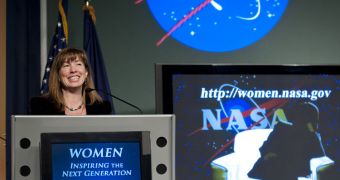While speaking at the International Symposium for Personal and Commercial Spaceflight yesterday, October 20, NASA Deputy Administrator Lori Garver explained that the agency cannot hope to achieve any of its ambitious goals for the coming decades without a solid private spaceflight industry.
The official told attendants that these companies need to handle as many of the trips scheduled to occur from Earth to its orbit. They must provide both suborbital joyrides and resupply capabilities for the International Space Station (ISS), leaving NASA free to focus on its own objectives.
Some corporations of the group NASA is currently funding under the Commercial Crew Development (CCDev2) program could start ferrying cargo to the ISS as soon as 2012-2013. At the same time, all these companies have plans to convert their cargo ships into manned spacecraft.
When and if that happens, NASA will have the ability to launch its own materials and astronauts to space aboard those capsule. In the mean time, the agency needs to pay large sums of money in order to foster the development of these replacement systems as fast as possible.
At the conference, Garver explained that the entire future of the American space agency's robotic exploration of space depends entirely on the success of private spacecraft development programs being conducted today. The future of the ISS may hang in the balance as well.
“In order to make good on the entire plan, it is this part of the plan that must be successful,” Garver said at the meeting. She naturally touched on the issue of the space shuttles, which were retired from active duty earlier this year, and are currently being prepared for exhibition in several museums.
“Contrary to what you might have heard, that marks the beginning, not the end. With the support of the President and Congress, NASA has made a renewed commitment to human spaceflight,” she added.
The central pillar of the new space plan is the construction of the Space Launch System (SLS), a heavy-lift rocket that will come in a light and heavy version. The latter will be larger and more powerful than the Saturn 5 delivery system that carried the Apollo modules to the Moon.
The other critical component is the Multi Purpose Crew Exploration Vehicle (MPCV), a capsule that is based on the Orion vehicle developed under Project Constellation. This will be the spacecraft that will take NASA astronauts to a near-Earth asteroid by 2025 and to Mars by the mid-2030s, Space reports.
Garver said that this project is very ambitious, and that this is why NASA needs to remain focused on it at all times. In order for that to happen, private corporations need to be able to conduct flights to low-Earth orbit and the ISS at regular intervals.
“Together we're developing an industry that until recently had largely been science fiction. We know we can work miracles together,” Garver added.

 14 DAY TRIAL //
14 DAY TRIAL //